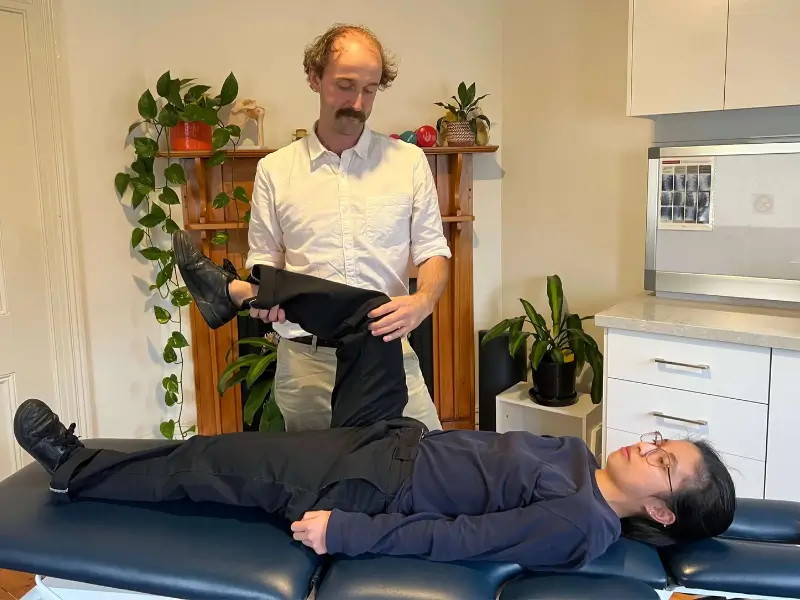
Rated 4.9 stars from 335+ reviews
We’re thrilled to announce receiving hundreds of five-star reviews! While we’d love to share these testimonials, regulations from the Australian Health Practitioner Regulation Agency (AHPRA) prevent us from displaying patient outcomes for regulated services such as Chiropractic, Physiotherapy, Osteopathy, Podiatry, and Acupuncture on this website. To read client feedback, please visit our Google Reviews directly.

Find lasting relief from sciatica with personalised care.
Living with sciatica can severely impact your quality of life, causing persistent pain and restricting mobility.
Sciatica is a symptom complex that can arise from various underlying issues such as lumbar disc herniation, spinal stenosis, or piriformis syndrome.
Understanding both the cause and appropriate treatment methods is crucial to effectively manage and alleviate symptoms.
Comprehensive Diagnosis and Evaluation
Effective treatment begins with a thorough diagnosis to identify the specific cause of sciatica.
Orthopaedic Evaluation:
Neurological Evaluation:
Diagnostic Tools:
These evaluations help create a comprehensive picture of the underlying issues causing sciatica. By combining these assessments with advanced diagnostic tools like MRI and CT scans, which provide detailed imaging of the spine, practitioners can pinpoint the exact source of nerve compression or irritation. This comprehensive approach is essential for developing targeted and effective treatment plans.
Coordinated Care for Your Pathway to Pain-Free Living
A collaborative approach is adopted, leveraging the expertise of independent chiropractors, physiotherapists, remedial massage therapists, and acupuncturists to provide a comprehensive treatment plan tailored to each individual’s needs.
Chiropractic Care:
Physiotherapy:
Remedial Massage Therapy:
Acupuncture:
Last Resort Measures:
Begin your journey to sciatica relief with an assessment by an independent chiropractor or physiotherapist—choose whichever you feel most comfortable with.
After a precise diagnosis of the primary cause of your sciatica, your assessing practitioner will craft a personalised treatment plan, combining their consultant knowledge for a truly collaborative approach.
Your practitioner recognises that effective management of sciatica involves multiple therapeutic methods. Their integrated approach tackles pain from multiple angles, enhancing your recovery for more sustainable results. Experience the power of collaborative care and take the first step towards a pain-free lifestyle. Together, you and your practitioner achieve better health outcomes and enhance your path to recovery.


Tailored Rehabilitation and Ergonomic Strategies for Lasting Relief
Your practitioner understands that each person’s journey with sciatica is unique, shaped by individual factors like age, spinal health, and lifestyle. Because of this, there is no one-size-fits-all solution when it comes to managing and treating sciatica. What works for one individual may not only be ineffective for another but could potentially lead to further complications.
That’s why your practitioner takes a highly personalised approach to Exercise and Rehabilitation. Rehabilitative exercises are introduced carefully, focusing on strengthening your muscles and enhancing spinal stability while considering your specific condition.
Your practitioner may recommend low-impact activities, such as swimming or gentle short walks, designed to rehabilitate your back without overtaxing it.
Similarly, your practitioner provides customised Ergonomic Adjustments to fit your daily needs. Proper posture and the use of ergonomic furniture are fundamental in alleviating lower back strain. Additionally, your practitioner emphasises safe lifting techniques and posture correction to prevent any further aggravation of your condition.
With a balanced and thoughtful approach, your practitioner ensures that every strategy recommended is tailored to your unique situation, supporting your journey toward recovery.
Unraveling Sciatica: Debunking Myths for Lasting Relief and Enduring recovery
Understanding sciatica is key to dispelling common myths, ensuring patients receive accurate information and the most effective treatment. Misconceptions about sciatica can often cause unnecessary worry, lead to inappropriate treatments, and prolong discomfort.
Myth 1: Sciatica is a condition on its own.
Truth: Sciatica is actually a symptom of an underlying condition, not a diagnosis in itself. It’s the result of nerve compression, often stemming from issues such as piriformis syndrome, facet joint dysfunction, sacroiliac joint dysfunction, or a herniated/bulging disc, just to name a few.
Myth 2: Rest is the best cure for sciatica.
Truth: While rest can alleviate acute pain temporarily, too much inactivity can worsen symptoms. Practitioners promote a balanced approach incorporating gentle activity to strengthen the back and improve mobility. However, it’s crucial to lock in the correct diagnosis before any home care advice is given.
Myth 3: All treatments for sciatica are the same.
Truth: The effectiveness of a sciatica treatment is heavily dependent on accurately diagnosing the underlying cause of the nerve irritation. Sciatica can be triggered by various conditions, each requiring a distinct treatment approach. For instance, what benefits a patient with sciatica due to a herniated disc might not be effective for someone whose sciatica stems from piriformis syndrome. Therefore, your practitioner should prioritise a thorough assessment to determine the specific cause of your sciatica, ensuring that the treatment plan is tailored to address your unique situation. This targeted approach enhances the effectiveness of the therapy and increases the likelihood of a successful recovery.
Myth 4: Physio vs. Chiro, one trumps the other for sciatica relief.
Truth: Your practitioner recognises that when it comes to treating sciatica, no single profession holds all the answers. While some might believe that one type of practitioner is superior to another, the truth lies in the experience and skill each brings to the table. This is why a collaborative approach is championed, uniting the expertise of independent chiropractors, physiotherapists, acupuncturists, and massage therapists. Each professional contributes a unique perspective and specialised techniques that, when combined, offer a well-rounded and effective treatment plan. The goal is to provide effective, non-surgical solutions and keep patients off the operating table. It’s not about choosing one discipline over another; it’s about bringing the best of all worlds together for your health and recovery.
Myth 5: Sciatica requires surgery.
Truth: Many believe that surgery is the only remedy for sciatica, but this is not typically the case. The majority of sciatica sufferers find relief through conservative approaches like chiropractic care, physiotherapy, and acupuncture. Surgery is reserved as a last resort, considered only when these non-invasive treatments do not provide relief or when nerve compression leads to severe symptoms such as significant weakness, or critical changes in bowel or bladder function.
It’s important to note that loss of bowel or bladder control is a medical emergency, requiring immediate attention at a hospital’s emergency department.
Myth 6: Sciatica is only a back problem.
Truth: While it’s true that the sciatic nerve originates in the lower spine from the combination of spinal nerves L4 to S3, its influence extends much further, impacting the buttocks, legs, and feet. This extensive reach is a consequence of the sciatic nerve’s route; it is the longest and widest nerve in the human body.
Practitioners craft treatment strategies to target the full length of the sciatic nerve, offering comprehensive and holistic relief. Additionally, it is critical to recognise that prolonged sciatica can lead to muscle atrophy, emphasising the importance of prompt and effective treatment to mitigate long-term physical impairment and ensure overall well-being.
Myth 7: Only older adults get sciatica.
Truth: Sciatica can affect individuals of any age, though it most commonly emerges between the ages of 25 to 50. This period often follows what many consider the “invincible stage” of youth, where health concerns, particularly those related to the back, may not seem as pressing. As individuals move past this phase and enter what might be termed their “sensible stage,” they often begin to take greater care of their lower back.
However, sciatica is not restricted to these age brackets alone. Degenerative changes in the spine, a natural part of ageing, can precipitate sciatica at various life stages, underscoring the importance of continuous attention to back health across all ages.
Myth 8: Sciatica is hereditary.
Truth: There is no real evidence to support the notion that sciatica is directly inherited. This means that even if your parents have suffered from sciatica, it doesn’t necessarily predispose you to the same condition. However, certain lifestyle habits that may influence sciatica—such as poor posture, improper lifting techniques, and a lack of physical activity—can be passed down through learned behaviours. Recognising and learning from these familial patterns allows you to adopt healthier habits. By being proactive about your spinal health and learning from your parents’ mistakes, you can lead an active, fulfilling life regardless of your family history.
At Brunswick Health, independent practitioners are committed to providing not only treatment but also education, ensuring that every patient understands their condition and the reasoning behind each recommended therapy. Join us as we tackle sciatica with informed, personalised care.
A warm-hearted approach, fueled by genuine passion, is dedicated to making a positive impact on your life.
Care and support are delivered with a commitment to not only meet but exceed expectations, ensuring a nurturing and welcoming experience you’ll truly value.
Since 1990, this collective has been a cornerstone of the community, earning trust and appreciation while joyfully supporting generations of families.
With over 65,500 patients treated, the journey is rich with stories of care, commitment, and lasting relationships.
100% money-back guarantee within 14 days if their service doesn’t meet your expectations, providing peace of mind on your health journey. They only take on cases where they are confident they can make a meaningful difference
This collective is proud to showcase hundreds of heartfelt 5-star Google reviews, reflecting the unwavering dedication of practitioners to excellence and patient satisfaction. Each review tells a story of trust, exceptional care, and the meaningful connections individual practitioners have built with those they serve.
In this cozy and welcoming collective hub, a spirit of inclusivity and vibrancy is celebrated. Here, humility meets excellence, and every moment is devoted to patient-centered care.
Your well-being isn’t just a priority—it’s the foundation of everything, ensuring you feel valued and supported every step of the way.
Browse our general FAQ for quick answers. For queries specific to a particular service,see the relevant service page.
Yes, all health practitioners using our facilities are registered providers and accept a variety of health insurance plans. For specific coverage details, please contact your insurance provider directly. Want to know more about our operating hours and fees? Curious about our operating hours and fees? Discover more here. For details on which radiological services, like MRIs or X-rays, are eligible for bulk billing, click to learn more.
Service fees vary based on the type and duration of treatment, and are set individually by each practitioner. For detailed pricing information, you can view the fees here or contact us directly, and our admin team will be happy to assist you.
Operating hours are set individually by each practitioner. We recommend confirming their availability directly with the practitioner, through our admin staff, or by using our online booking system.
You can contact your treating practitioner directly, reach out to our admin staff, or use our online booking system.
We are conveniently located in the heart of Brunswick for easy access to all local residents.
Address: 1/68 Melville Road Brunswick, VIC 3055
Areas We Serve
Brunswick, Brunswick West, Brunswick East, Essendon, Moonee Ponds, Parkville, Coburg, Carlton, Fitzroy, Pascoe Vale South, Pascoe Vale, Thornbury, Northcote.

